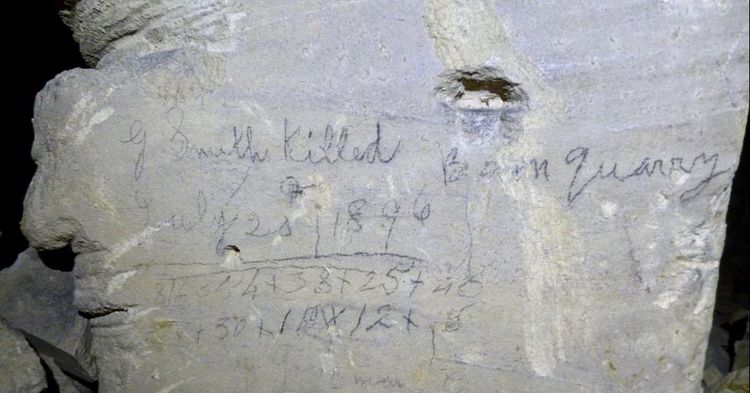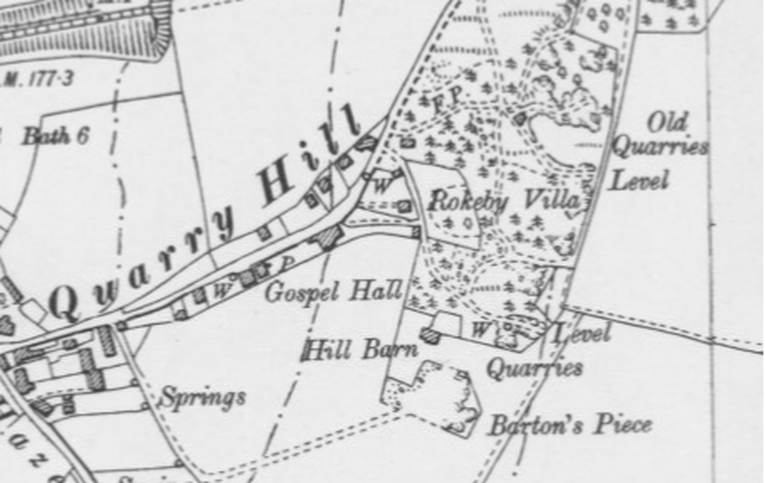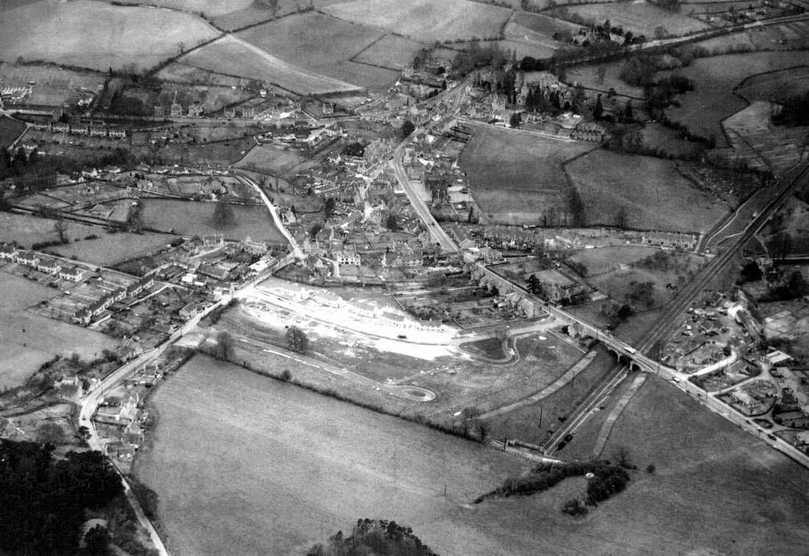Barn Piece, Quarry Hill Mark Jenkinson February 2018
In 1933, two sisters went into labour at a similar time and were put into adjacent beds at the Royal United Maternity Hospital, Bath. It made a small article in the local paper, which recorded that one sister was having her first child, whilst the other had unfortunately just lost her sixth baby.[1] The parents were Mr and Mrs Hawkins of Drewetts Mill House and one of the sisters, Mrs Winnifred White, lived at number 7, Council Houses, Box, meaning Barn Piece.
The Rural District Council approved the first twelve tenants to go into the houses in November 1931 as:[2]
|
WE Mortimer, from 3 Prices Buildings
VG Sandell, Fairfield, Bath H Simpkins, Box Hill FT Strange, Mill Lane WH Bollen, Pickwick SJ Brunt, The Parade |
AW Boulton, Queen's Square
H Hawkins, Kingsdown F Hancock, Box Hill A Phelps, Market Place AHC Taylor, Box Hill AAP Vaughan, Potley Lane |
The houses were built by Wiltshire Council as social housing to try to alleviate the crisis of inadequate homes after the First World War. Numbers 1 to 12 had been built by 1932 and the remaining eight houses followed.[3] Mr Brooke, chairman of Box Parish Council, confirmed that the tenants were not selected as persons, but was based on information about the number and sexes of the children, the type of existing accommodation and the reason for wanting a move. Applicants were restricted to those living or working in the Rural District Council area, who had paid existing rents on time.
They were possibly completed in a rush as by 1937 tenders were invited for repainting the first 12. They were also built before modern facilities were standard in houses. By 1953 several tenants wanted improvements, probably meaning indoor toilets, bathrooms and modern kitchens.[4]
Speculations on the Name Barn Piece
My interest in the origins of Barn Piece overlaps with my interest of old quarry graffiti. There is a quarry inscription, G Smith killed [in] Barn quarry July 20th 1896.[5] Barn Quarry is not a widely used label, unlike many of the quarries around Box Hill that were individually named but ultimately merged into the later maze-like complex. I cannot recall its being referred to in any other graffiti although Liz Price gave it a general name-check, Others (smaller quarries) include Barn Quarry on Box Hill.[6]
They were possibly completed in a rush as by 1937 tenders were invited for repainting the first 12. They were also built before modern facilities were standard in houses. By 1953 several tenants wanted improvements, probably meaning indoor toilets, bathrooms and modern kitchens.[4]
Speculations on the Name Barn Piece
My interest in the origins of Barn Piece overlaps with my interest of old quarry graffiti. There is a quarry inscription, G Smith killed [in] Barn quarry July 20th 1896.[5] Barn Quarry is not a widely used label, unlike many of the quarries around Box Hill that were individually named but ultimately merged into the later maze-like complex. I cannot recall its being referred to in any other graffiti although Liz Price gave it a general name-check, Others (smaller quarries) include Barn Quarry on Box Hill.[6]
The 1896 underground graffiti is in the Lower Hill Series (the Quarry Hill area rather than further north), so putting two and two together, along with a bit of wishful thinking, I’m wondering if the naming of Barn Piece suggests a notable barn at the southern end of the quarry workings, perhaps Hill Barn shown in the map of 1900 below. The word piece was often used to describe plots of land adjacent to specific workings or an industrial area, such as a mill and, as the map below shows, there was an adjacent area of land called Barton's Piece.
We can speculate that part of the purpose of the barn may have been to house quarry horses and agricultural equipment because in 1907 the auctioneers Tilley & Parry held a sale of Horses etc Barn Piece, Quarry Hill.[7] Was this the last agricultural use of the barn? The horses had probably gone by the time the houses were built but there were still fields and Mr Strange of number 2 advertised Two hives of hardy bees.[8]
Anna Grayson Wrote
I have come to the conclusion that in all probability the Barn in the photo at the heading is the one that Uncle Cecil Lambert talked about. I say this because the other side of the valley is in the correct alignment. It could have been taken from what is now the large field and was the stony area in the photo. The stone in the foreground looks like quarry waste not quarrying, which would have followed beds of stone. I remember them as about chest high and forming the boundary to a paddock area. I wonder if any of the quarry stones remain.
Marriage of Residents 1939 - 45
Many of the children were now young adults by the start of the Second World War. Miss K Mortimer of number 1 was appointed one of a dozen assistants in the 1938 Bath Carnival Queen contest.[9] Many sought a marriage before war took their spouses away. Betty Constance Grace Smith, youngest daughter of Mrs Bray at number 16, was married to Stanley Arthur Gale of Corsham in 1939.[10]
Children of the newer houses were also marrying by 1940. Elizabeth Lydia Frayling of number 17 married Charles Helps with difficulty when the gates of Bathford churchyard were locked and the couple had to endure a prolonged confetti barrage.[11] Phyllis Ivy May Johnson of number 13 married on Boxing Day 1940.[12] Iris E Phelps of the Post Office telephone and engineering department, who lived at number 6, married an active serviceman.[13] Nancy E Moody of number 18 married David Glover who was working at Eastlays quarry.[14] James Mitten, a bus conductor employed by Bristol Tramways, of number 19 married in July 1941.[15]
The list of occupiers in 1939 is shown in the dropdown below:
Anna Grayson Wrote
I have come to the conclusion that in all probability the Barn in the photo at the heading is the one that Uncle Cecil Lambert talked about. I say this because the other side of the valley is in the correct alignment. It could have been taken from what is now the large field and was the stony area in the photo. The stone in the foreground looks like quarry waste not quarrying, which would have followed beds of stone. I remember them as about chest high and forming the boundary to a paddock area. I wonder if any of the quarry stones remain.
Marriage of Residents 1939 - 45
Many of the children were now young adults by the start of the Second World War. Miss K Mortimer of number 1 was appointed one of a dozen assistants in the 1938 Bath Carnival Queen contest.[9] Many sought a marriage before war took their spouses away. Betty Constance Grace Smith, youngest daughter of Mrs Bray at number 16, was married to Stanley Arthur Gale of Corsham in 1939.[10]
Children of the newer houses were also marrying by 1940. Elizabeth Lydia Frayling of number 17 married Charles Helps with difficulty when the gates of Bathford churchyard were locked and the couple had to endure a prolonged confetti barrage.[11] Phyllis Ivy May Johnson of number 13 married on Boxing Day 1940.[12] Iris E Phelps of the Post Office telephone and engineering department, who lived at number 6, married an active serviceman.[13] Nancy E Moody of number 18 married David Glover who was working at Eastlays quarry.[14] James Mitten, a bus conductor employed by Bristol Tramways, of number 19 married in July 1941.[15]
The list of occupiers in 1939 is shown in the dropdown below:
| barn_piece_occupiers_in_1939.doc | |
| File Size: | 25 kb |
| File Type: | doc |
After the War
We get some idea of the poverty which existed after World War 2 when Gwenilian Thomas, a former resident of the Thornypits Hostel now living at 19 Barn Piece, was charged with stealing a towel and a pair of gloves from another resident of the hostel.[16] In the scarcity of houses in post-war England, disputes arose over the disclosure of information by prospective tenants in 1950, which shows the esteem in which these properties were held.[17]
We get some idea of the poverty which existed after World War 2 when Gwenilian Thomas, a former resident of the Thornypits Hostel now living at 19 Barn Piece, was charged with stealing a towel and a pair of gloves from another resident of the hostel.[16] In the scarcity of houses in post-war England, disputes arose over the disclosure of information by prospective tenants in 1950, which shows the esteem in which these properties were held.[17]
Many of the houses in the lane are more recent in-fill properties. In the 1950 aerial photo of Bargates you can see that the houses on the upper/east side of Barn Piece are already there, but many of those on the west were built later. Those on the downhill side of the road were built in 1960s.
References
[1] Bath Weekly Chronicle and Herald, 9 September 1933
[2] The Wiltshire Times, 28 November 1931
[3] Donald Andrews, who lived at number 8, quoted in https://www.francisfrith.com/uk/hawthorn,wiltshire/memories
[4] The Wiltshire Times, 11 July 1953
[5] RJ Tucker, Scripta Legenda Vol I, 1974, Free Troglophile Association Press, p.16
[6] Liz Price, Bath Freestone Workings, 1984, The Resurgent Press, p.57
[7] The Wiltshire Times, 21 September 1907
[8] The Wiltshire Times, 31 March 1934
[9] Bath Weekly Chronicle and Herald, 21 May 1938
[10] Bath Weekly Chronicle and Herald, 28 January 1939
[11] Bath Weekly Chronicle and Herald, 30 March 1940
[12] Bath Weekly Chronicle and Herald, 28 December 1940
[13] Bath Weekly Chronicle and Herald, 18 April 1942
[14] The Wiltshire Times, 8 June 1940
[15] The Wiltshire Times, 19 July 1941
[16] The Wiltshire Times, 5 March 1949
[17] The Wiltshire Times, 25 March 1950
[1] Bath Weekly Chronicle and Herald, 9 September 1933
[2] The Wiltshire Times, 28 November 1931
[3] Donald Andrews, who lived at number 8, quoted in https://www.francisfrith.com/uk/hawthorn,wiltshire/memories
[4] The Wiltshire Times, 11 July 1953
[5] RJ Tucker, Scripta Legenda Vol I, 1974, Free Troglophile Association Press, p.16
[6] Liz Price, Bath Freestone Workings, 1984, The Resurgent Press, p.57
[7] The Wiltshire Times, 21 September 1907
[8] The Wiltshire Times, 31 March 1934
[9] Bath Weekly Chronicle and Herald, 21 May 1938
[10] Bath Weekly Chronicle and Herald, 28 January 1939
[11] Bath Weekly Chronicle and Herald, 30 March 1940
[12] Bath Weekly Chronicle and Herald, 28 December 1940
[13] Bath Weekly Chronicle and Herald, 18 April 1942
[14] The Wiltshire Times, 8 June 1940
[15] The Wiltshire Times, 19 July 1941
[16] The Wiltshire Times, 5 March 1949
[17] The Wiltshire Times, 25 March 1950



